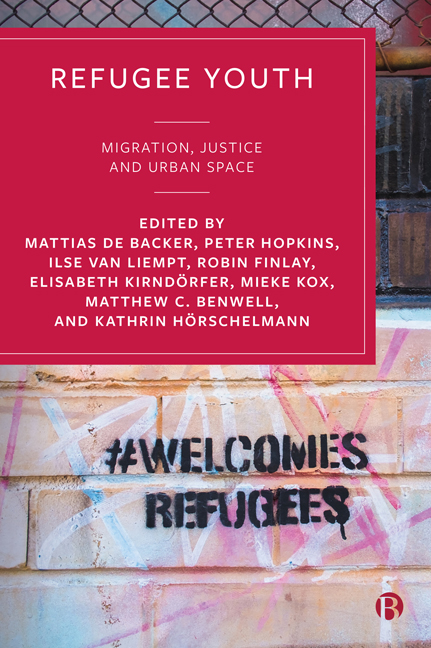Book contents
- Frontmatter
- Contents
- List of Figures and Tables
- Notes on Contributors
- Acknowledgements
- 1 Introducing Refugee Youth: Migration, Justice and Urban Space
- 2 Storying Belonging, Enacting Citizenship? (Dis)articulations of Belonging in a Community Theatre Project with Young Refugees and Asylum Seekers in Leipzig, Germany
- 3 Jackets and Jewellery: Racialised Dispossession and Struggles over Public Space in Denmark
- 4 Venezuelan Refugee Youth and Brazilian Schooling: The Individual between Languages and Spaces
- 5 The Inclusionary Potential and Spatial Boundaries of (Semi-)Public Space: Refugee Youth’s Everyday Experiences in the Urban Fabric of Amsterdam
- 6 Navigating ‘Purdah’ Culture in Urban Space: The Restricted Lives of Young Married Rohingya Refugees in Malaysia
- 7 Inclusive Urban Planning and Public Space for Refugee Youth in Pursuit of a Just City in Amman, Jordan
- 8 Sense of Belonging among Tibetan Refugees in India: A Case Study of the Bylakuppe Settlement in Karnataka, India
- 9 Negotiating Identity in Urban Space: Everyday Geographies of Syrian Students in Istanbul
- 10 ‘You’re Judged a Lot’: Australian Sudanese and South Sudanese Youths’ Perspectives on Their Experiences in Public Spaces
- 11 Hair Salons as ‘Private-Public Spaces’: Exploring the Experiences of Young Migrant Women in an Urban Township in South Africa
- 12 Emotion and Spatial Belonging: Exploring Young Migrant Men’s Emotional Geographies in Cork, Ireland
- 13 Homemaking through Music in Urban Africa: Creating Opportunities as a Refugee and a Migrant in Kinshasa and Dar es Salaam
- 14 Planetary Listening
- 15 Refugee Youth: Politics, Publicness and Visibility
- Index
5 - The Inclusionary Potential and Spatial Boundaries of (Semi-)Public Space: Refugee Youth’s Everyday Experiences in the Urban Fabric of Amsterdam
Published online by Cambridge University Press: 18 January 2024
- Frontmatter
- Contents
- List of Figures and Tables
- Notes on Contributors
- Acknowledgements
- 1 Introducing Refugee Youth: Migration, Justice and Urban Space
- 2 Storying Belonging, Enacting Citizenship? (Dis)articulations of Belonging in a Community Theatre Project with Young Refugees and Asylum Seekers in Leipzig, Germany
- 3 Jackets and Jewellery: Racialised Dispossession and Struggles over Public Space in Denmark
- 4 Venezuelan Refugee Youth and Brazilian Schooling: The Individual between Languages and Spaces
- 5 The Inclusionary Potential and Spatial Boundaries of (Semi-)Public Space: Refugee Youth’s Everyday Experiences in the Urban Fabric of Amsterdam
- 6 Navigating ‘Purdah’ Culture in Urban Space: The Restricted Lives of Young Married Rohingya Refugees in Malaysia
- 7 Inclusive Urban Planning and Public Space for Refugee Youth in Pursuit of a Just City in Amman, Jordan
- 8 Sense of Belonging among Tibetan Refugees in India: A Case Study of the Bylakuppe Settlement in Karnataka, India
- 9 Negotiating Identity in Urban Space: Everyday Geographies of Syrian Students in Istanbul
- 10 ‘You’re Judged a Lot’: Australian Sudanese and South Sudanese Youths’ Perspectives on Their Experiences in Public Spaces
- 11 Hair Salons as ‘Private-Public Spaces’: Exploring the Experiences of Young Migrant Women in an Urban Township in South Africa
- 12 Emotion and Spatial Belonging: Exploring Young Migrant Men’s Emotional Geographies in Cork, Ireland
- 13 Homemaking through Music in Urban Africa: Creating Opportunities as a Refugee and a Migrant in Kinshasa and Dar es Salaam
- 14 Planetary Listening
- 15 Refugee Youth: Politics, Publicness and Visibility
- Index
Summary
Introduction
Staring through the windows of a community centre in the east of Amsterdam, we see newcomers and their teachers leaving the different classrooms and heading to the central room. There, they meet other people, have a chat and intermingle while queuing for a warm, free lunch. Once they have received a plate, they try to find a seat to have their lunch on one of the six-person tables in the central room and continue their conversations or start a new one with other people. These newcomers with different nationalities, ethnicities, ages, gender and legal statuses (refugees and asylum seekers as well as unauthorised migrants), meet and interact with each other and with Dutch volunteers, neighbours and employees of the centre.
Before the start of the COVID-19 pandemic, this scene could be observed in a community centre in the east of Amsterdam on a daily basis. It illustrates how newcomers are engaged in remaking everyday life in a new context after their migration. These processes are not only taking place in their own neighbourhoods, as sometimes is suggested in classical migration literature. They also take place in the dynamic space of the city, where there is a wide range of opportunities to make connections with others. As such (semi-)public spaces within cities offer great potential for the inclusion and participation of new groups (for example, Caglar and Glick Schiller, 2018; Darling and Bauder, 2019; Nettelbladt and Boano, 2019). However, participatory fieldwork among refugees in a community centre shows that it is not that straightforward for refugees to exploit the potential of public spaces in the city immediately after arrival.
Building new connections through (semi-)public space
Our conceptualisation of public space in this chapter refers to a variety of physical places (topographies) in the city, like streets, pavements, parks and squares, which are accessible to ‘the public’ (Carr et al, 1992). This accessibility is important and refers to the dimension of ownership that has traditionally been the distinguishing factor between the public and the private (Madanipour, 2003). This understanding suggests a somehow binary opposition between public and private space, whereas in practice the degree of ‘publicness’ of urban public spaces differs from place to place and from time to time, and is constantly shifting (Mitchell, 2003).
- Type
- Chapter
- Information
- Refugee YouthMigration, Justice and Urban Space, pp. 65 - 80Publisher: Bristol University PressPrint publication year: 2023



